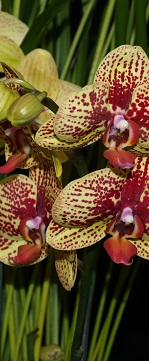PLENTY OF VARIETY
Orchids are a very large and diverse range of plants. As a result, naming of genus is not always as straight forward as it could be. There are literally hundreds of new cultivars and two or three new genus (intergeneric) registered every month. Classification is an evolving science and changes are occurring on a continual basis. Here are some examples that may assist you in finding information out about those orchids which are hard to locate.
Some plants, which are actually hybrids, have been given an intergeneric name that is used as the genus. Others have been given one name which is later changed, or reclassified, to another name. For instance, plants in the genus Rhyncholaelia were once considered to be of the genus Brassavola. Some sources now class them separately, as we have here in this book, while some have chosen to keep them as Brassavola. Most newer text will use the two separate names, or indicate that they are sometimes considered synonymous. However, especially in older text, this is not always the case.
Cross pollination of orchids to create a new, unique plant is a regular occurrence. In some instances, the resulting hybrid is referred to as a new genus. These names are actually intergeneric names. For example, Zygowarrea is the genus name for a cross of Warrea lindley x Zygopetalum hooker (Zygo + Warrea). All other plants then hybridised from Zygowarrea will likely be given the intergeneric genus name of Zygowarrea. Intergeneric names can also be named in honour of a particular person, and usually occurs when several plants have been crossed to breed the plant. For instance, the intergeneric name Alangreatwoodara is in honour of plant breeder Alan Greatwood, with the original plant in the "genus" being a cross of three orchids.
To add to the confusion, all genus and intergeneric names are given an abbreviation. So, you may see a plant identified as Ascda. 'Park Yon Kyoung'. In this instance, the full stop is in place, giving the indication that an abbreviation is being used. However, if that full stop does not appear, as is often the case, there is no indication that Ascda is the accepted abbreviation for the genus Ascocenda.
We have covered a great range of orchids in this course, but due to the constant changes as detailed above, it is nearly impossible to include every genus, intergeneric name and cultivar in one publication. However, with this knowledge of how the names evolve, it can assist you in finding out about your orchids, with a little detective work.
Orchid Growing Tips
· Most orchids require a very loose open potting mix. These are commonly made from mainly shredded or milled bark, or tree fern fibre.
· In cool climates never water orchids until the bark on the surface of a pot feels dry. Never let the entire pot dry out!
· When watering with a hose, keep the water jet soft and don't wash bark away from any roots.
· Don't water any orchids with icy cold water. Generally make sure water is at least 15 °C. This may mean filling a watering can with water from your hose, and if it is a bit cold, adding some warmer water from a hot tap. Be careful not to add too much hot water!.
· Overwatering is more likely to kill an orchid than underwatering. Keep orchids relatively dry when growth is slow or dormant.
· Generally the thicker the stem of the orchid (often called a pseudobulb) the less often it needs to be watered, unless conditions are very hot and dry.
· Avoid potting up orchids into too large a pot. Pot up a pot bound plant into a pot only one or two pot sizes at a time, no more).
· Keep a look out for pests, in particular, aphis, snails, scale or mealy bug insects, and use control methods as soon as they appear.
· Keep orchids in places where conditions are not likely to be changeable.
· In cool climates, don't place them inside near an open window, where cold draughts of air could be a problem.
· Keep them away from gas heaters or stoves.
· Avoid an inside window sill or bench where they will get direct, hot sunlight. Indirect light is preferred by the majority of orchids.
· Avoid direct sun in the hottest part of the day, and generally provide shade in summer.
· Protect flower buds from direct sun, wind, aphids, snails and slugs.
· Do not overfeed. If in doubt, feed regularly with quarter strength fertilisers.
Why Study with ACS?
Design your own learning pathway.
Study at your own pace, from anywhere, at any time.
Receive prompt, expert support from our team of committed and friendly tutors.
Your learning is our priority. We are flexible and adaptable to meet your educational needs!